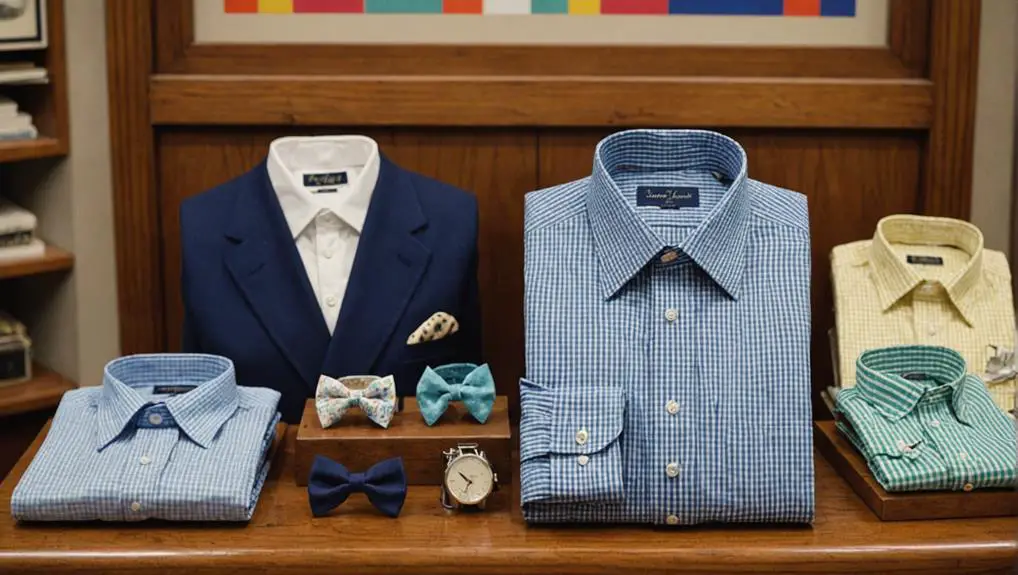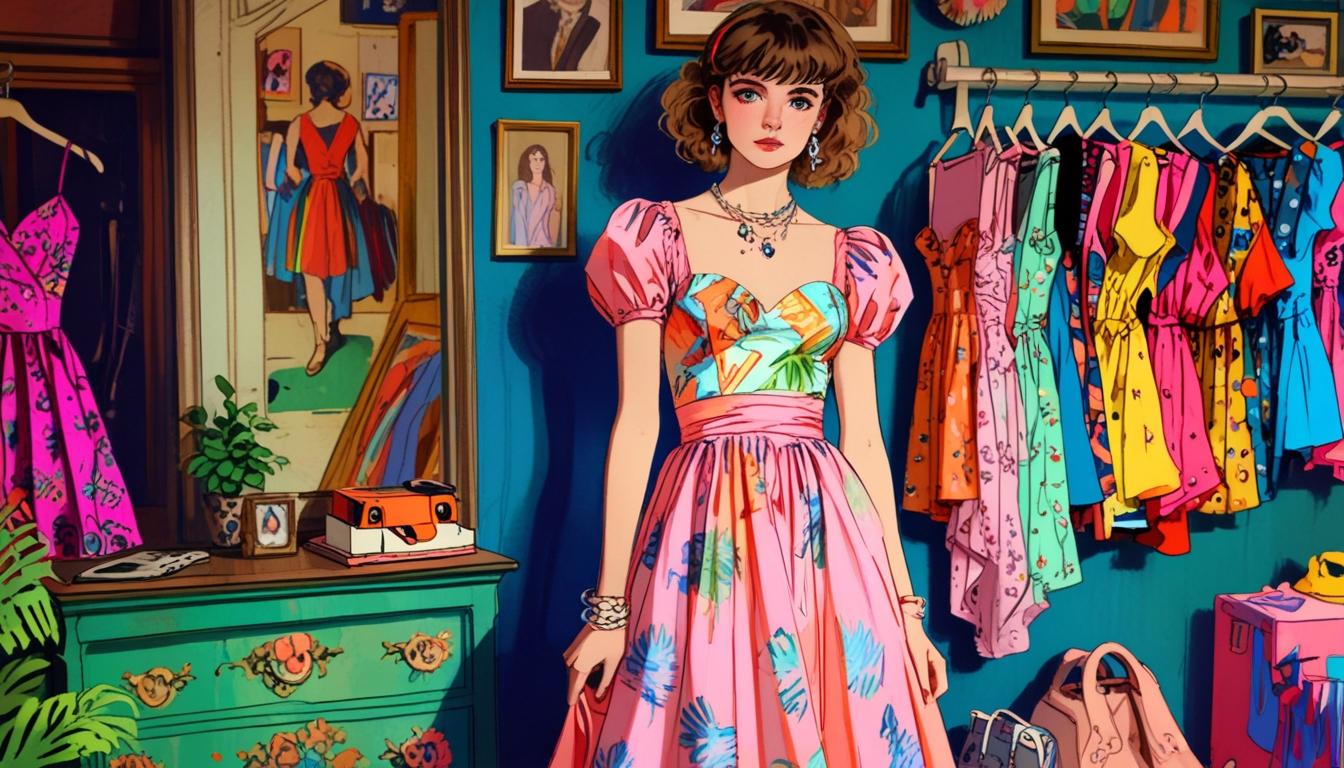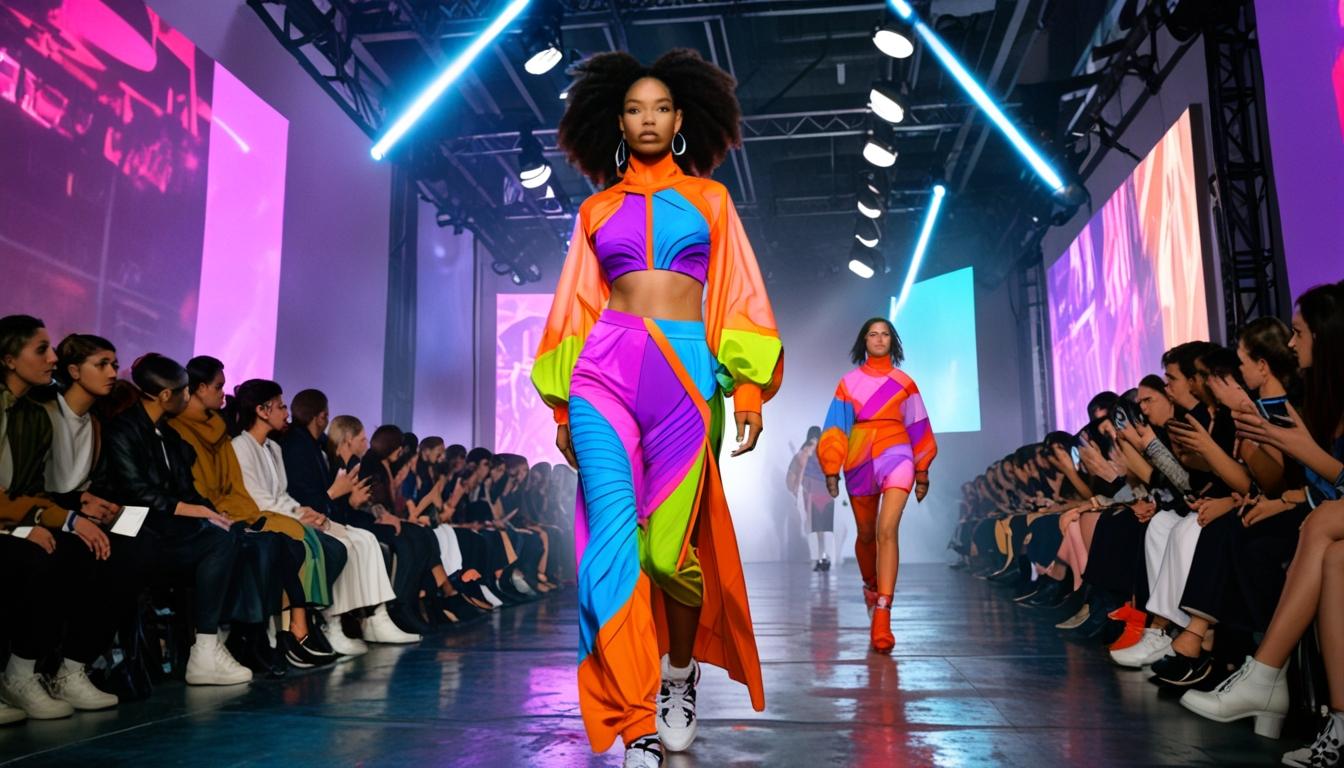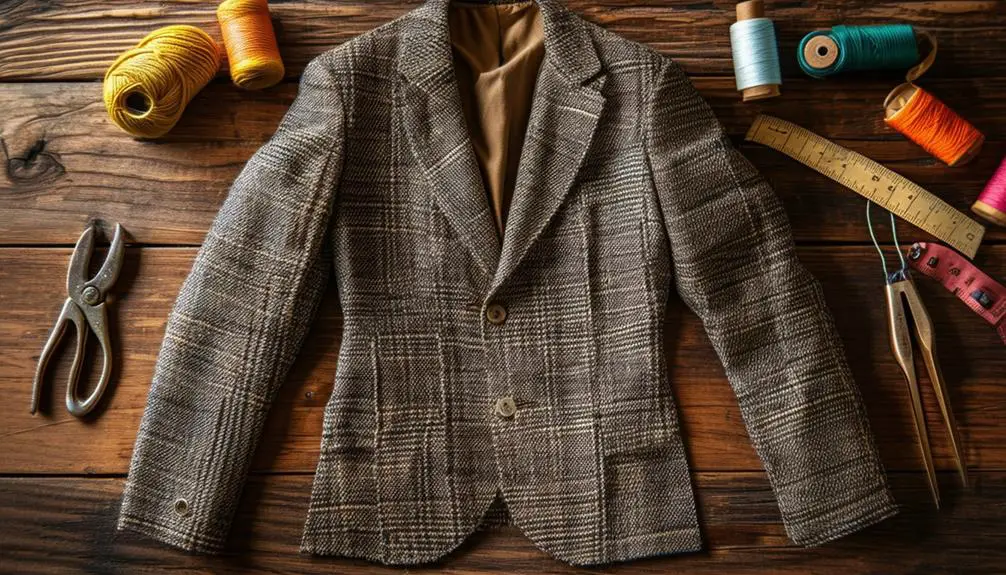Men's dress shirts in the 1950s showcased a blend of tradition and modernity. You'd notice a shift from bold patterns to vibrant solid colors and soft pastels. Fabrics evolved too, with lightweight cotton and innovative synthetics like Dracon enhancing comfort and maintenance. Collar styles varied widely, favoring wide spreads and crisp button cuffs, while short sleeves emerged as a new trend by the decade's end. Brands like Manhattan and Arrow defined quality, offering various designs to fit formal and casual settings. Understanding these trends could deepen your appreciation for vintage fashion and its cultural significance.
Overview of 1950s Dress Shirts
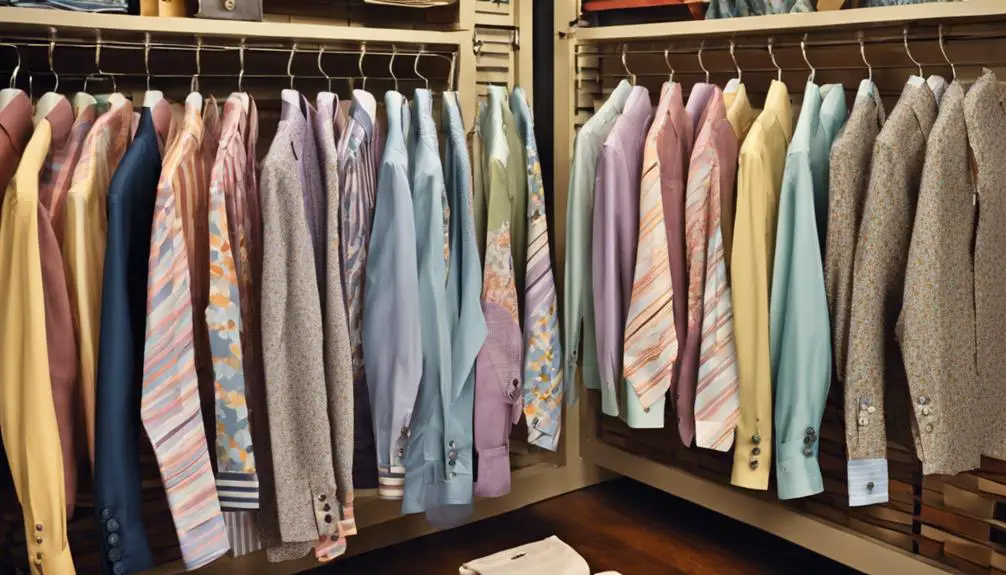
In the vibrant world of 1950s fashion, men's dress shirts underwent a remarkable evolution that reflected broader cultural shifts. You'd notice a significant departure from the bold patterns of previous decades, as vibrant tropical colors, soft pastels, and solid shades took center stage. This transformation mirrored a growing desire for individuality and self-expression among men, aligning with the trends in vintage clothing labels that defined the era.
Collar styles also evolved, with wide spread and modified spread collars becoming increasingly popular. You might even find yourself drawn to the revival of rounded point (club) collars, which added a touch of vintage charm. The cuff designs were equally diverse; while simple button cuffs remained a staple, the elegance of double French cuffs captured attention, with cuff links emerging as a fashionable accessory.
As comfort became paramount, the introduction of synthetic fabrics, like Dracon, revolutionized the design of these shirts. You could enjoy wash-and-wear options that made maintaining your long sleeve dress shirt effortless. By 1958, short sleeve dress shirts made their debut, specifically designed for formal occasions, often paired with neckties, showcasing the decade's adaptability to warmer seasons and evolving fashion sensibilities.
Popular Fabrics and Materials
The evolution of men's dress shirts in the 1950s wasn't just about styles and cuts; it also marked a significant shift in the fabrics and materials used. You'd find a blend of traditional and innovative textiles, catering to the changing lifestyles of the era. Lightweight cotton broadcloth became a staple, prized for its breathability and comfort. This made it an ideal choice for cotton leisure shirts that were both stylish and functional.
As the decade progressed, synthetic fabrics like polyester and Dracon gained popularity, marketed for their affordability and easy care. The rise of wash-and-wear fabrics transformed the way you approached shirt maintenance, drastically reducing the need for ironing. Rayon and linen also made their mark, particularly during the summer months, providing a cool and comfortable option for warmer days.
Wool blends emerged as a reliable choice for winter dress shirts, ensuring warmth without sacrificing style. Innovative fabric blends were developed to enhance durability and performance, responding to the evolving demands of everyday wear. Fundamentally, the 1950s redefined men's dress shirts, marrying comfort, practicality, and style through a diverse array of materials.
Color Trends in Dress Shirts
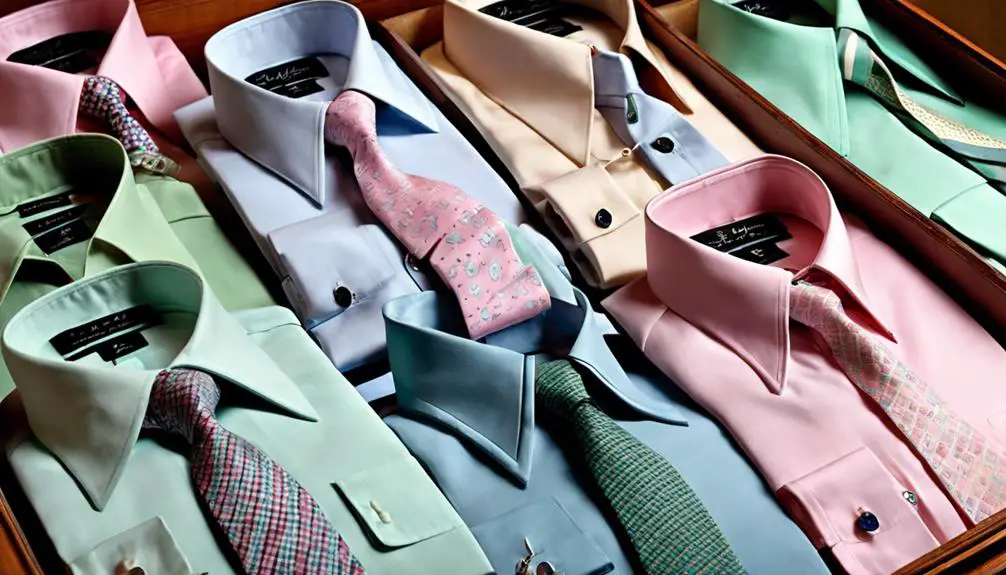
A vibrant palette emerged in men's dress shirts during the 1950s, reflecting a cultural shift towards bolder fashion choices. At the start of the decade, you might've noticed an array of pastel shades like baby blue, pink, and off-white, which catered to the softer aesthetics favored during this time. However, as the decade progressed, solid colors became the dominant choice for men's dress shirts.
By the late 1950s, your options were more streamlined, and you'd find yourself drawn to these popular hues:
- White
- Light Blue
- Grey
- Pink
- Tan
Patterns on dress shirts also saw a decline, with small pinstripes gaining prominence while bolder designs faded away. This change towards solid colors was greatly influenced by the desire to complement textured suits and bold ties, creating a balanced and sophisticated look. Ultimately, the color trends of the 1950s not only reflected personal style but also echoed broader cultural shifts, making your choice in men's dress shirts a statement of individuality and modernity.
Collar and Cuff Styles
Collar and cuff styles in the 1950s showcased a fascinating evolution that mirrored the decade's fashion-forward mindset. The period saw a rise in various collar styles, particularly modified spread collars and the resurgence of rounded point club collars, characterized by their shorter and softer designs. Long point collars maintained a classic length of 2.5 inches, while the short point collars, introduced in 1953, offered a more compact 2-inch length, catering to emerging trends.
As for cuffs, French cuffs gained immense popularity, often marketed as elegant options for formal wear. These cuffs paired beautifully with cuff links, enhancing their vintage style and sophistication. On the other hand, button cuffs remained a staple, providing a simpler, yet stylish alternative for everyday wear. The era also witnessed the introduction of double French cuffs, which catered to those desiring a more refined look.
Additionally, the use of British tabs and collar pins became prevalent, offering a polished appearance to collar points. This attention to detail not only elevated the overall aesthetic of men's dress shirts but also reflected the sartorial aspirations of the 1950s, making them timeless pieces in fashion history.
Short Sleeve Dress Shirts
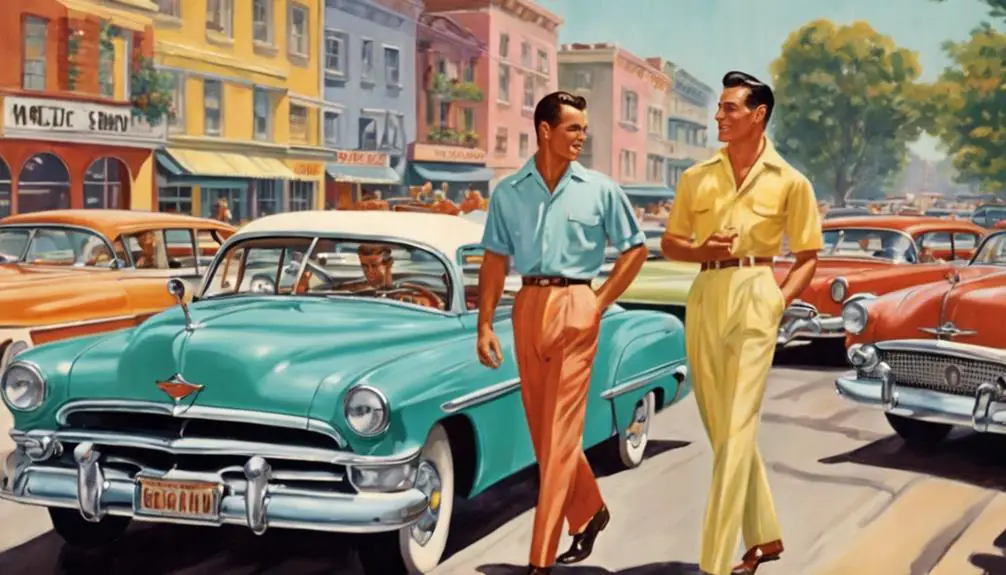
Introducing short sleeve dress shirts in 1958 revolutionized men's formal wear, offering a stylish alternative for warmer climates. These shirts emerged as a response to the need for comfort without sacrificing elegance, blending seamlessly into the evolving landscape of men's shirt styles. Initially met with skepticism, short sleeve dress shirts eventually became a recognized staple, proving versatile for various occasions.
Key characteristics of short sleeve dress shirts included:
- Solid colors that maintained a polished appearance
- Often paired with neckties to elevate the formal look
- Wide spread collars that provided a modern touch
- French cuffs echoing the sophistication of their long-sleeved counterparts
- A retro vibe that appealed to the fashion-forward man of the time
Unique Vintage Brands
As the popularity of short sleeve dress shirts gained momentum, the 1950s also witnessed the emergence of unique vintage brands that defined men's fashion during the decade. Brands like Manhattan and Arrow became household names, with Manhattan's Golden Needle dress shirts offering a blend of quality and style, while Arrow's innovative collar designs revolutionized tuxedo and dress shirts. The identification of these brands through their vintage clothing labels enhances our understanding of their historical significance and value.
Van Heusen stood out by providing a wide range of options, including both formal tuxedo shirts and casual styles, catering to every occasion. Christian Dior elevated the era with luxury plaid silk shirts, emphasizing sophistication and elegance that were hallmarks of 1950s fashion.
The Kleinhans Co. carved out its niche with unique tuxedo shirts, showcasing the diverse offerings available to consumers. You'll also find NOS (New Old Stock) brands like Excello and Penneys emphasizing craftsmanship and quality materials, which were pivotal to the era.
From button-down dress shirts to western shirts, these vintage brands not only shaped men's shirts but also reflected the cultural zeitgeist of the time, making them essential pieces in understanding 1950s fashion.
Pricing and Market Insights
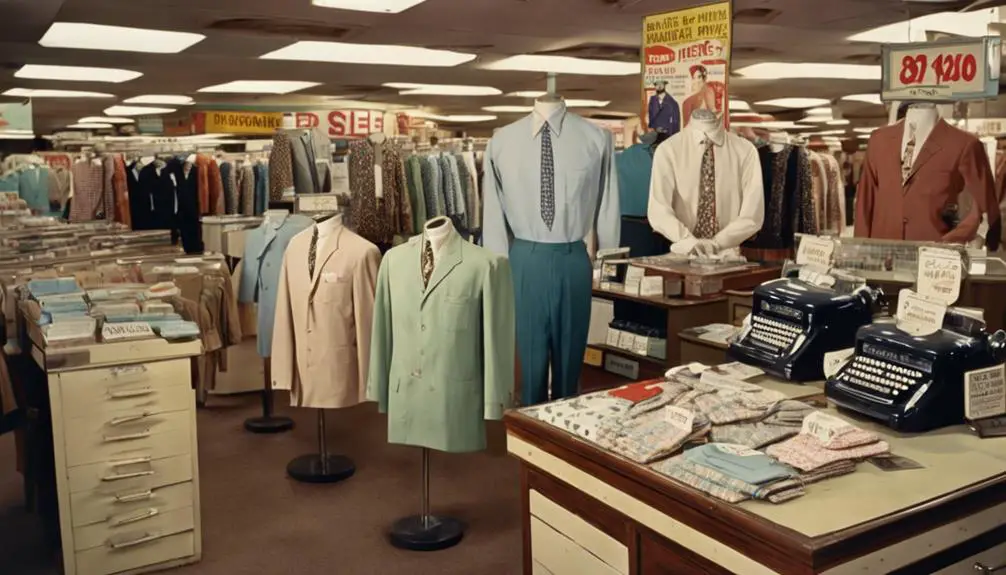
Maneuvering the market for vintage dress shirts from the 1950s can be both exciting and challenging. When you're searching for authentic vintage mens shirts, understanding the pricing landscape is essential. Prices generally range from $39.99 to $250.00, influenced by brand, rarity, and condition. Notable brands, like Van Heusen and Arrow, provide a spectrum of options, with tuxedo shirts commanding higher prices due to their formal appeal.
Here are some key factors to take into account:
- Brand Reputation: Higher-end brands can greatly impact pricing.
- Condition: Shirts in pristine condition will typically fetch a premium.
- Design Rarity: Unique patterns or historical significance can drive prices up.
- Shipping Costs: Be mindful; these can range from $4.43 to $50.00.
- Negotiation Options: Many listings feature a "best offer" option, allowing for price negotiations.
With collectors and fashion enthusiasts keen to find distinctive pieces, you'll often see competitive pricing. By keeping these insights in mind, you'll enhance your chances of snagging that perfect 1950s button-up shirt at a fair price.
Fashion Influences and Trends
Understanding the pricing landscape for vintage 1950s dress shirts sets the stage for appreciating the fashion influences and trends that defined the era. During this decade, men's dress shirts shifted from vibrant patterns to solid colors, with a noticeable rise in the popularity of white and light blues. This change highlighted a desire for simplicity and sophistication in men's fashion.
Collar styles evolved dramatically, favoring wide spread and modified spread collars, along with a revival of the rounded club collar. These styles catered to both formal and casual occasions, allowing you to tailor your look for various settings. The emergence of synthetic fabrics, like polyester, made dress shirts more affordable and easier to maintain, broadening your options for vintage attire.
The introduction of short sleeve dress shirts in 1958 represented a blend of formal styling and comfort, appealing to your need for versatility during warmer months. Influenced heavily by Hollywood stars, casual shirts became increasingly fashionable, marking the rise of the teenager as a distinctive fashion demographic. The Rockabilly shirt, in particular, captured the spirit of youthful rebellion, intertwining music and fashion in a uniquely 1950s manner.
Frequently Asked Questions
What Kind of Shirts Did Men Wear in the 50s?
In the 50s, you'd notice men wearing a range of dress shirts, featuring various collar styles and colors. Fabrics evolved too, with options prioritizing ease of care, while cuff designs added sophistication to their attire.
What Were Men Expected to Wear in the 1950s?
In the 1950s, you were expected to wear tailored clothing that emphasized neatness. Suits, ties, and polished shoes were essential, reflecting a cultural shift towards formality and sophistication in everyday men's fashion during that era.
How to Dress Like a 1950S Man?
To dress like a 1950s man, you'll want to embrace classic styles. Opt for fitted trousers, tailored jackets, and polished shoes while incorporating subtle patterns and vibrant accessories to achieve that iconic, sophisticated look.
Did Men Wear Suspenders in the 50s?
Yes, men wore suspenders in the 1950s to maintain a polished look. Often paired with high-waisted trousers, they allowed for personal expression, though their popularity waned as belts emerged as the preferred style by the late decade.
